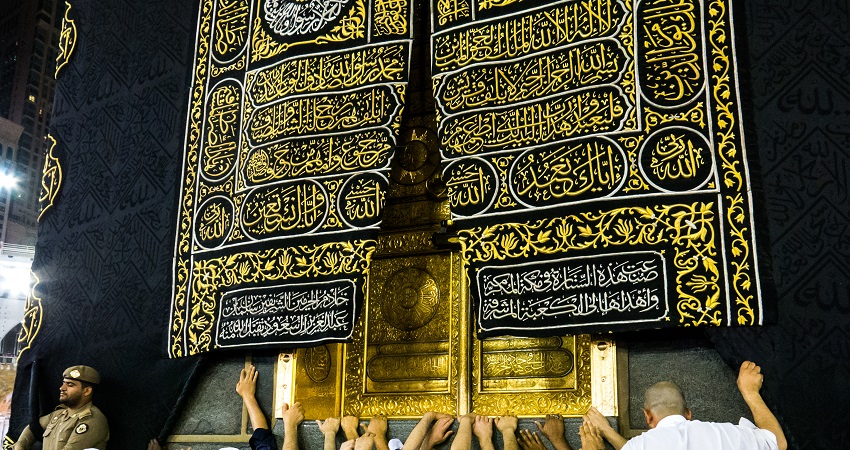At the centre of Al-Haram mosque in Makkah, stands the most sacred building called the Kaaba. It is of great importance in Islamic culture. People going to Saudi Arabia for Hajj or Umrah, circle seven times around the Kaaba in a counter-clockwise direction offering prayers to Allah. Only a few people have seen or are aware of what is inside Kaaba. In this blog, we try to look at what is and was inside the Kaaba.
The Kaaba was built by the Prophet Ibraham and His son Ismael to honour God. Observants face it while offering prayers to the Almighty, five times a day. Over the centuries, the structure has seen several modifications. This makes the outside structure and the inside view of Kaaba, magnificent. The latest changes were made in the 1950s to accommodate the large number of pilgrims coming for Hajj. The government of Saudi Arabia extended the boundaries of the Mosque, which now spread over 40 acres of land.
The Kaaba stands as a cubical building with a 15m height. The corners were designed to align with the cardinal directions. In 1982, the door was beautified with solid gold. The black silk cloth piece, called Kiswah, which covers Kaaba, used to come from Egypt with the caravan of pilgrims coming for Hajj. Today, Saudi Arabia produces that cloth piece. It has calligraphy done in gold thread that represents the verses of the Quran in Arabic. Every year on the second day of Hajj, the cloth is replaced by another one.
The Importance of Kaaba
The Holy Kaaba, also know as Khana Kaaba is not the actual house of God, but it is a metaphorical place of Allah’s residence. It refers to the oneness of the supreme power in Islamic beliefs. The pre-Islamic groups followed idols and worshipped many gods. They kept the idols inside the Kaaba. It is said that Prophet Mohammad (PBUH) received instruction from God to restore Kaaba into a place to worship only one God. It marked the end of polytheism among the groups, and the Kaaba became the centre of worship for the followers of Islam.
The Kaaba and the Black Stone signify the unification of all Muslims and are a safe house for them. No one worships the Black Stone or the Kaaba. They, together, stand for the supreme power that is Allah. It is direction, or Qilba, which the followers of Islam around the world face while offering prayers to God.
What is Inside The Kaaba?
Kaaba means ‘cube’ in Arabic. It is a black stone structure in the middle of the Grand Mosque. On its eastern side, the Black Stone is believed to have fallen from heaven in the times of Adam and Eve. According to the Islamic culture, Prophet Mohammad (PBUH) kissed the stone inside Kaaba, and following his path, pilgrims try to kiss it when performing Hajj or Umrah.
A Graphic view of inside the Kaaba, 360 degree view
Video Credit – İslam’ın Işığında Araştırma
Khana Kaaba Inside: Area & Structure
It covers 180 square metre area and has three wooden columns that hold the ceiling in place. Each column is about 1,350 years old and has a perimeter of 150cm with a diameter measuring 44cm. A pillar passes through each of these columns and is used to suspend gifts in the building. The three pillars were built by Abdullah bin Zubair, an important Muslim leader and one of the compilers on the Quran. There exists an enclosed staircase that leads to a hatch, which is a closed rectangular structure without windows; it just has a door that leads to the ceiling. A silk curtain with gold and silver engravings covers the door. Also, the Kaaba did not have a roof until the Quraysh rebuilt it. They added a roof to the structure and also closed the west door.
The Kaaba Floor
The floor of the Kaaba interior is constructed from marble, and the walls have emblazoned colourful marbles. Red silk curtains with white embroidered texts cover the interiors of the Kaaba as well as its ceiling. There are eight stones with Arabic calligraphy inside the Khana Kaaba. Different scripts were used to inscribe on these stones. There are specific markings on the floor that signify the spot where Prophet Muhammad is believed to have prayed when he entered the Kaaba. The kinds of Saudi Arabia pray on that spot.
When pilgrims arrive in large numbers during Hajj, the beautiful Kaaba remains closed. The right to enter, see what is inside Kaaba and adore its beauty is reserved for Muslim dignitaries.
The Stone Inside Kaaba
The black polished stone inside Kaaba consists of some fragments and three large pieces held together by a silver band. A stone ring also surrounds them. According to legends, the stone came with Adam, and was initially white in colour. The sins of pilgrims who touched and kissed it turned it to the black color that it currently is. It has also been stolen in the past. In 930, the Black Stone was taken away by the fanatics of the Qarmatian sect, a branch of the Sevener Ismaili Shia Islam group. Currently, under the rule of the King, the Black Stone is protected by 24 guards.
The Black Stone placed on one of the edges of The Kaaba measures 30cm in diameter and stays 1.5m above the ground. When people Perform Tawaf (circling around the Kaaba), they try to kiss it, and if they cannot, then they must point at it. While crossing it, one must recite takbeer “Allahu Akbar”.
There are many folklores around the existence and establishment of the stone inside the Kaaba. According to another popular theory, Prophet Ibraham and his son Ismael were looking for different types of stones to build the Kaaba when they came across this Black Stone. Upon recognising its value, they put it at the corner of the building.
Facts About The Holy Kaaba
- The holy Kaaba was rebuilt several times in the past due to the effects of natural and manmade calamities. The structure before Islam was used to keep idols of different Gods of Arab tribes. The latest repair of Kaaba took place in 1999.
- Before the holy Kaaba was draped in the black Kiswa, it had numerous colors primarily that of green, white and red.
- In the past, the holy Kaaba was open to every Muslims twice in a week. However with the surge in pilgrims from around the world, the Kaaba gets opened twice in a year for Muslim VIPs.
- Inside the holy Kaaba, there is a plaque that has the names of all the rulers that were a part of the reconstruction of Kaaba.
- Originally the Kaaba was to be built in a semi circular shape but due course in time it attained the structure of a cube as it has now.
- Before Islam, the old Kaaba inside consisted of numerous idols that were worshipped by pagans who used to live in the area.
All popular legends only emphasize and reiterate the significance of the Black Stone and the Kaaba. For Muslims, it is the holiest place on Earth, the house of Allah, where all men must surrender and pray to the one Almighty; where all duas are accepted and all sins are forgiven. It is the path to jannah, also known as jannat or paradise, where there is no sadness, sickness, pain, grief, or suffering – only eternal happiness.
Inside The Holy Kaaba FAQs
What is the holy Kaaba?
At the centre of the Al-Haram mosque in Makkah, stands the most pious structure called the Kaaba. It is vital in Islamic culture. Individuals going to Saudi Arabia for Hajj or Umrah circle seven times around the Kaaba a counter-clockwise way offering prayers to Allah. It is vital in Islamic culture.
Who built the holy Kaaba?
The holy Kaaba was built by Prophet Ibraham (PBUH) and his son Ismael to honor God.
What is the area and structure of the holy Kaaba?
It covers a 180 square meter area and has three wooden columns that hold the ceiling in place. Each column is about 1,350 years old and has a perimeter of 150cm with a diameter measuring 44cm.
What is the significance of the holy Kaaba?
The Holy Kaaba (Khana Kaaba) is not the actual house of God, but it is a metaphorical place of His residence. It refers to the oneness of the supreme power in Islamic beliefs.
How can one know about the names of rulers who renovated the holy Kaaba?
The Kaaba interior houses a plaque with the names of rulers who took part in the renovations of the holy Kaaba.
Is the inside of holy Kaaba accessible to all?
In past it was, but today only Muslim dignitaries have the permission to go inside the holy Kaaba.







